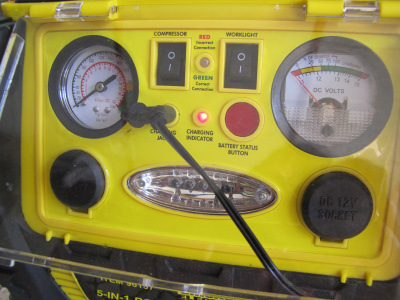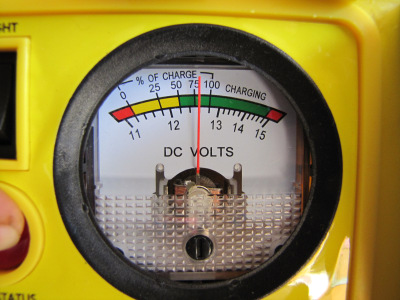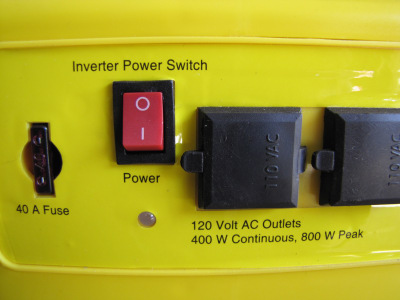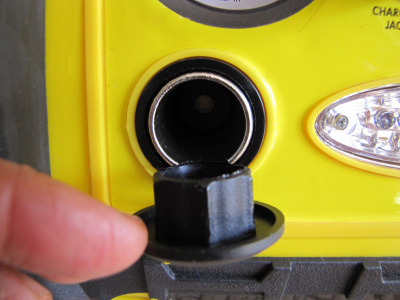
Chicago Electric 5-in-1 Power Pack Review
 Even
though we haven't set up the solar panels from our plug
and play solar backup
yet, I wanted to test out our Chicago Electric 5-in-1 Portable Power
Packs and see what kind of use we'll be able to get out of them.
We charged the power packs up using house AC for 48 hours (as
instructed in the manual), then I plugged my laptop into one power pack
and turned on the inverter. Everything was going just
fine...until 13 minutes later, my laptop stopped drawing juice. I
turned the inverter off and on again --- still no electricity.
Did I break it already?
Even
though we haven't set up the solar panels from our plug
and play solar backup
yet, I wanted to test out our Chicago Electric 5-in-1 Portable Power
Packs and see what kind of use we'll be able to get out of them.
We charged the power packs up using house AC for 48 hours (as
instructed in the manual), then I plugged my laptop into one power pack
and turned on the inverter. Everything was going just
fine...until 13 minutes later, my laptop stopped drawing juice. I
turned the inverter off and on again --- still no electricity.
Did I break it already?
 After a more thorough read of
the manual, it sounds like it's best to turn the power pack's inverter
on for a two minute warmup, turn it off, plug in the laptop, then turn
the inverter back on. After following those directions, my laptop
ran quite happily for another three and a half hours. It probably
would have run longer, but we want our power pack's battery to last as
long as possible, so I turned it off when the indicator hit 50% charged.
After a more thorough read of
the manual, it sounds like it's best to turn the power pack's inverter
on for a two minute warmup, turn it off, plug in the laptop, then turn
the inverter back on. After following those directions, my laptop
ran quite happily for another three and a half hours. It probably
would have run longer, but we want our power pack's battery to last as
long as possible, so I turned it off when the indicator hit 50% charged.
 Even
though my laptop's power block rates its energy consumption at 60
watts, a previous experiment with a kill-o-watt device estimated the
laptop's actual usage at 25 watts. (The much higher wattage
listed on the power block assumes that I have lots of USB devices
plugged in, which I seldom do.) So I drew roughly 94 watt-hours
from the power pack --- a bit less than half of the 216 watt-hours the
battery is rated at holding.
Even
though my laptop's power block rates its energy consumption at 60
watts, a previous experiment with a kill-o-watt device estimated the
laptop's actual usage at 25 watts. (The much higher wattage
listed on the power block assumes that I have lots of USB devices
plugged in, which I seldom do.) So I drew roughly 94 watt-hours
from the power pack --- a bit less than half of the 216 watt-hours the
battery is rated at holding.
The only (very minor)
flaw with the power pack is that the inverter has a fan that's about as
loud as a desktop computer. I'd gotten used to the near silence
of my laptop, but I know I  won't be complaining about a
little white noise when I enjoy nearly four hours of laptop use during
a power outage.
won't be complaining about a
little white noise when I enjoy nearly four hours of laptop use during
a power outage.
Although I'm quite
pleased, I've got another trick up my sleeve to stretch our power pack
usage further. The power pack has two cigarette-lighter-type
slots in the front, so I'm going to buy a "car charger" for my laptop
and see how much more runtime I can get when I'm not wasting energy
converting DC to AC and back to DC. Stay tuned for more
information as the experiment progresses.
Want more in-depth information? Browse through our books.
Or explore more posts by date or by subject.
About us: Anna Hess and Mark Hamilton spent over a decade living self-sufficiently in the mountains of Virginia before moving north to start over from scratch in the foothills of Ohio. They've experimented with permaculture, no-till gardening, trailersteading, home-based microbusinesses and much more, writing about their adventures in both blogs and books.
Want to be notified when new comments are posted on this page? Click on the RSS button after you add a comment to subscribe to the comment feed, or simply check the box beside "email replies to me" while writing your comment.

The rated power on a power supply will always be higher than the normally used power. Power supplies are designed and rated for a worst-case scenario.
Mind you, this is a good thing! If you use a power supply over its rated capacity you may get voltage drops which can crash the laptop if you're not using the built-in battery. It might also affect the lifetime of the power supply negatively.
If you switch off all the power saving features, turn up the screen brightness to maximum and play DVDs constantly and attach lots of USB gadgets, you would see a marked increase in power usage.